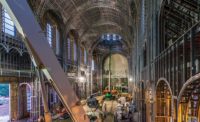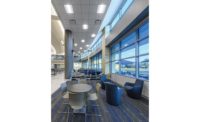
Most people probably don’t think of their city’s legislative chambers as a warm, inviting space … unless they live in Chandler, Arizona. The city was one of the largest in the state without a permanent city hall until November 2010, when it opened a newly constructed city hall complex. As part of the facility’s design, city officials desired a space within the complex that residents would view as a gathering place.
According to design principal, Mark Roddy of SmithGroup in Phoenix, Arizona (the architectural firm responsible for the design of the facility) the city hall’s council chambers became that space. “We knew they wanted to make it special,” he says, “so it was important that we give it a warm, inviting feel.”
Describing the design aesthetic for the chamber, Roddy explains that it was meant to be an iconic element within the entire complex. At the same time, the design team wanted to create a space that was both intimate and unique.
SAW-TOOTH WOOD CEILING
The highlight of the new council chamber is a dramatic, 6,000-square-foot saw-tooth wood ceiling installed in a series of clouds. “The ceiling is a very prominent design element in the space,” Roddy notes. “It adds a dynamic quality to the room that is noticed as soon as people walk in.”
He explains that the design team decided to use a series of folding saw-tooth ceiling clouds instead of one continuous expanse of ceiling. “The use of clouds adds a sense of scale to the space while still leaving the impression of more volume and space above the ceiling,” he says. Each bay of wood ceiling clouds is installed independent of the others and finished with trim.
The ceiling itself is made of Armstrong WoodWorks Tegular Custom 1-foot by 8-foot planks in a bamboo patina veneer perforated for sound absorption. Roddy explains that bamboo patina was selected because of its combination of texture and grain.
MANY INSTALLATION CHALLENGES
TP Acoustics Inc. of Phoenix was responsible for the installation of the chamber ceiling. It also installed over 4,000 square feet of Armstrong Woodworks Custom 4-foot by 8-foot wall panels in a matching bamboo finish around the perimeter of the chamber and above the dais.
Claude Amerson, president of TP Acoustics, explains that one of the keys to winning the job was his firm’s experience in the installation of specialty metal and wood ceilings. “Over the years, we had completed a number of complex projects for both the architect and the general contractor, so they knew what we were capable of,” he says.

Second, was its elevation. The chamber floor slopes down theater-style from the back of the room to the front, while the ceiling slopes up in the opposite direction from the front of the room to the back.
WOOD CEILING IN LOBBY
Yet another challenge was the serrated design of the ceiling. “We’ve installed saw-tooth ceilings before but not in wood,” states vice president of operations, Derrick Amerson. “On this job, each individual bay of ceiling clouds is installed independent of the other and finished with trim. In addition, because of the articulated design of the ceiling, special connection clips between the trim and the grid had to be custom made.”
Custom 1-foot by 8-foot WoodWorks planks from Armstrong were also installed in a series of clouds in the lobby outside the chamber. While not as intricate as the serrated ceiling in the chamber, this floating ceiling was also sloped and had to follow the curve of the building, all of which contributed to the difficulty of its installation.
CANTED CHAMBER WALLS
The chamber walls presented their own set of challenges. Amerson notes, for example, that it was important to maintain a level elevation for the light pocket atop the wall panels even though the floor was sloped. To complicate the installation, the wall panels were not plumb against the wall, but canted out 3 to 6 degrees depending on the floor elevation.
“Where this really became demanding was in the radiused corners, especially on the front wall because those panels are articulated in a design similar to the ceiling,” he says. “The combination of having to deal with the degree of pitch, the radius, and the need to stay on module made framing, bracing and overall installation difficult.”
Custom-sized wood wall panels were also installed on the media wall or soffit located in front of and above the council dais. Once again, installation was made more difficult by the fact that the soffit was radiused and pitched out at an angle.
PRE-PLANNING WAS KEY
In addition to the installation challenges, Claude Amerson says a number of other factors were vital to the success of the project. “Pre-planning was key, and we were able to get involved early in the design process, which helped immensely,” he states.
“Similarly, a great deal of coordination between us and Armstrong was needed before the product actually arrived in order to meet the construction schedule,” he adds. “The goal was to allow panels to be manufactured to custom sizes that we could install straight from the crate. Considering that essentially none of the products were standard, this was quite an accomplishment.”



Report Abusive Comment